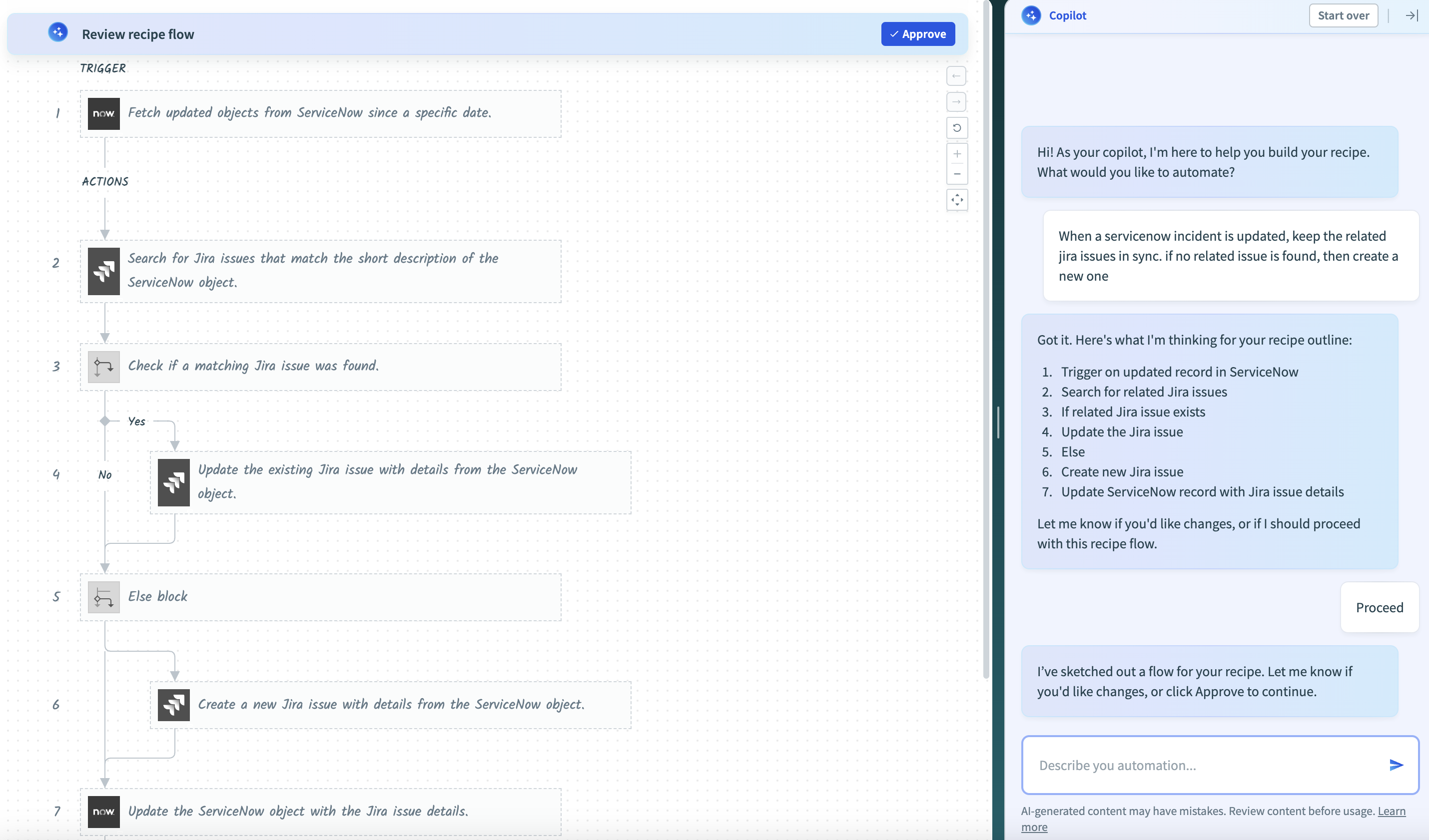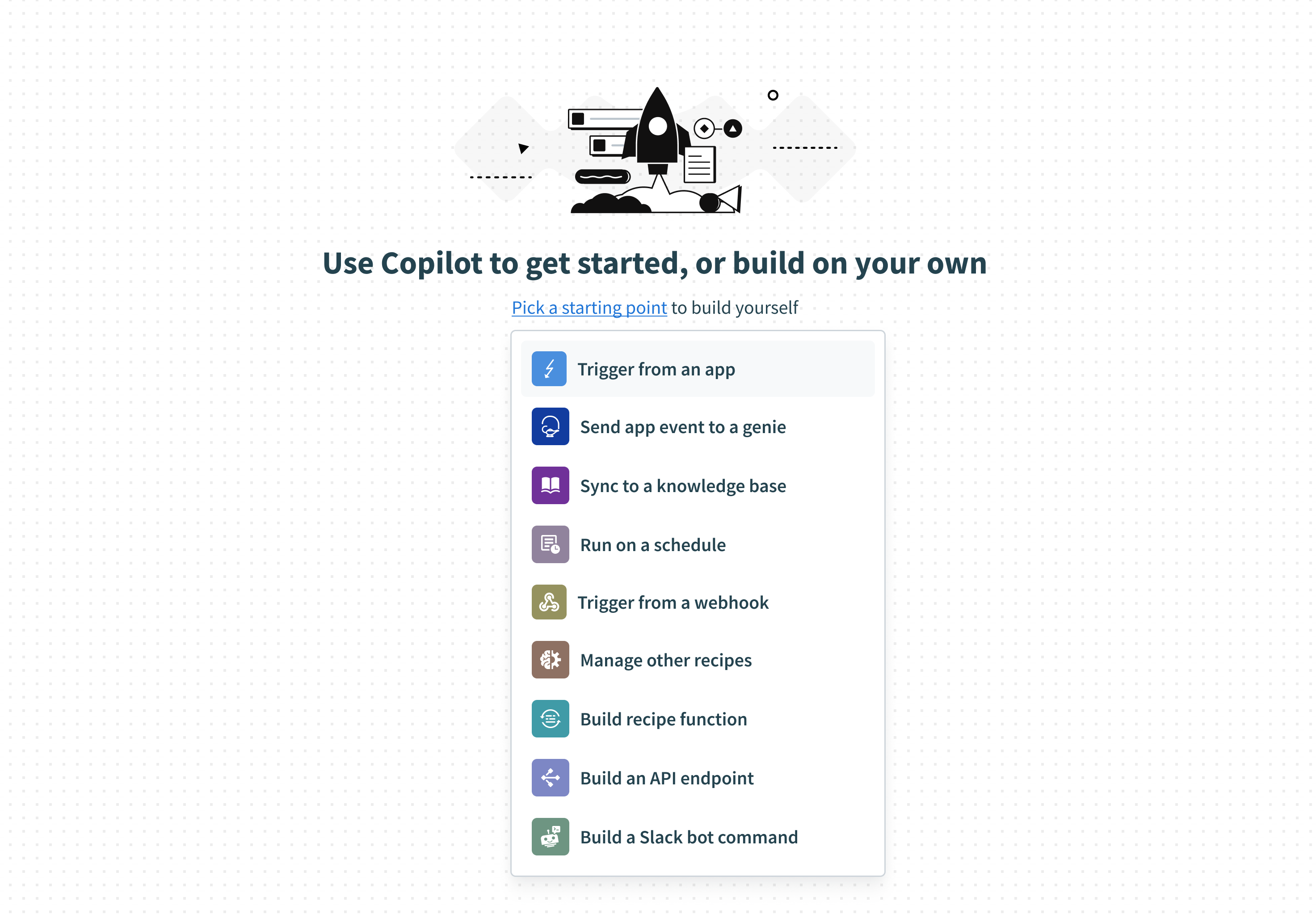# Recipes
A recipe is an automated workflow that executes a series of steps to integrate and process data across multiple applications.
SUMMARY
- Recipes use connectors to integrate with different apps, enabling seamless data flow and process automation.
- Workato supports different types of recipes, including workflow recipes, API recipes, data pipeline recipes, app event recipes, and knowledge base recipes for various automation needs.
- You can create recipes manually or use Recipe Copilot, AI-powered guidance for faster recipe development.
# What is a recipe?
A recipe is an automated workflow that executes a series of steps to integrate and process data across multiple applications.
Every recipe has a trigger, which defines the event that starts the workflow. When triggered, the recipe performs one or more actions, such as creating a corresponding contact in Salesforce or sending a welcome email. Recipes use connectors to interact with different apps, ensuring seamless data flow across systems.
Recipes support both simple and complex workflows, with features like conditional logic for decision-making, loops to process datasets, and error handling to manage exceptions.
# What types of recipes can I create?
You can create various types of recipes in Workato:
Workflow recipes: These are the most common recipes used to automate tasks between different applications. Workflow recipes can include triggers, actions, conditional logic, loops, and error handling to manage complex workflows.
API recipes: These recipes allow you to create and expose API endpoints using the API platform. They enable external users, other recipes, or integrated systems to access and exchange data securely. API recipes are useful for sharing data with partners or different accounts, such as providing real-time inventory status to suppliers. Learn more about API recipes.
Data pipeline recipes (currently in private preview): These recipes simplify the setup, management, and monitoring of data pipelines by enabling seamless data movement from a source to a destination. They can ingest thousands of objects in a single step, automatically matching schemas as data moves across systems. Data pipeline recipes are ideal for syncing data to warehouses, running post-load transformations, and building ETL/ELT workflows. Learn more about data pipeline recipes.
App event recipes: These recipes send real-time business events from external applications to a genie. This enables the genie to take over part of the process, such as researching, analyzing, or drafting messages, and notify users when processing is complete or when it requires further input or approval. Learn more about app event recipes.
Knowledge base recipes: These recipes automate the process of syncing, storing, and updating documents or textual content into a genie's knowledge base. By specifying how data from external sources is ingested and stored as searchable knowledge, these recipes enable genies to answer questions and support workflows using up-to-date information. Learn more about knowledge base recipes.
COMMUNITY LIBRARY
Need inspiration? You can clone recipes from the community library (opens new window) and modify them to fit your use case.
Learn more about the community library.
# Create a new recipe
Complete the following steps to create a new recipe:
Sign in to Workato.
Click the Recipes tab.
Click Create, then select Recipe.
Enter a name for your recipe in the Name field.
Select the project or folder where you plan to store your recipe from the Location drop-down menu.
Click Start building to open your new recipe in the recipe editor.
From here, you can use Recipe Copilot to assist in building your recipe or select a starting point to create your recipe manually.
# Recipe Copilot
Recipe Copilot uses Large Language Models (LLMs) to augment and accelerate your recipe-building experience. This AI-powered feature guides users of all experience levels through the recipe creation process, offering suggestions and auto-completing tasks to expedite development.
 Recipe outline in Recipe Copilot
Recipe outline in Recipe Copilot
Refer to the Recipe Copilot documentation for more information.
# Recipe starting points
If you choose to build your recipe manually, you have several options for the starting point of your recipe:
- Trigger from an app: Choose an app and trigger event to start your recipe.
- Send app event to a genie: Use the Workato Genie Send business event action to pass business context to a genie. The genie can then take over part of the process and either notify you when it's done or request guidance for next steps.
- Sync to a knowledge base: Use the Workato Genie Store knowledge action to fetch data from external sources such as websites, documents, or databases, and store it as searchable documents within the genie's knowledge base.
- Run on a schedule: Use the Scheduler by Workato New recurring event trigger to run your recipe at specified intervals, such as once a week. You can also use cron expressions to create customized schedules.
- Trigger from a webhook: Use the Webhooks New event via HTTP webhook trigger to activate your recipe in real-time when webhook events are sent to a generated webhook address.
- Manage other recipes: Use RecipeOps by Workato to monitor and manage other recipes, jobs, or your Workato account.
- Build recipe function: Create a recipe function with the Recipe function by Workato New call for function trigger.
- Build an API endpoint: Use the API platform by Workato New API request trigger to create API-based recipes.
- Build a Slack bot command: Use the Workbot for Slack New command trigger and Post command reply action to automate Slack interactions.
 Select a starting point
Select a starting point
FURTHER READING
Last updated: 12/1/2025, 6:09:01 PM